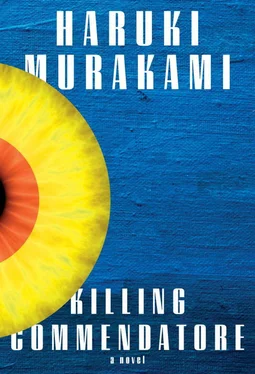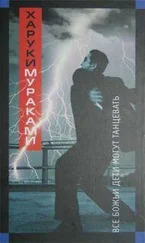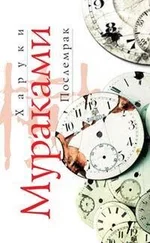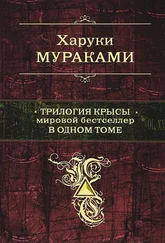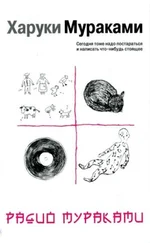Underneath the layers of wrapping paper was a painting in a simple frame, wrapped in a soft white cloth like bleached cotton. I gently lifted off that cloth, as carefully as if I were removing the bandages from a burn victim.
What was revealed under the white cloth was, as expected, a Japanese-style painting. A long, rectangular painting. I stood it up on a shelf, stood back a bit, and studied it.
It was Tomohiko Amada’s work, no doubt about it. Clearly done in his style and inimitable technique, with his signature bold use of space and dynamic composition. The painting depicted men and women dressed in the fashions of the Asuka period, the clothes and hairstyles of that age. But the painting startled me nonetheless. What it depicted was so violent it took my breath away.
As far as I knew, Tomohiko Amada hardly ever painted pictures that were harsh and violent. Maybe never. His paintings mostly summoned up feelings of nostalgia, gentleness, and peace. Occasionally they would take up historical events as his theme, but the people depicted in them generally faded away into the overall composition. They were shown as part of a close community in the midst of the abundant natural scenery of ancient times, esteeming harmony above all. Ego was submerged in the collective will, or absorbed into a calm fate. And the circle of life was quietly drawn closed. For Tomohiko Amada that very well may have been utopia. Over the years he continued to depict that world from all sorts of angles, all sorts of perspectives. Many called his style a “rejection of modernity” or a “return to antiquity.” Of course there were some who criticized it as escapist. In any case, after he returned to Japan from studying in Vienna he abandoned modernist oil painting, and shut himself away inside that kind of serene world, without a single word of explanation or justification.
But this painting titled Killing Commendatore was full of blood. Realistic blood flowing all over. Two men were fighting with heavy, ancient swords, in what seemed to be a duel. One of the men fighting was young, the other old. The young man had plunged his sword deep into the old man’s chest. The young man had a thin black mustache and wore tight-fitting light-greenish clothes. The old man was dressed in white and had a lush white beard. Around his neck was a necklace of beads. He had dropped his sword, which had not yet struck the ground. Blood was spewing from his chest. The tip of the sword must have pierced his aorta. The blood had soaked his white clothes, and his mouth was twisted in agony. His eyes were wide open, staring in disbelief into space. He realized he was defeated. But the real pain had yet to hit him.
For his part, the young man’s eyes were cold, fixed on his opponent. Not a sign of regret in those eyes, not a hint of confusion or fear, or a trace of agitation. Totally composed, those eyes were simply watching the impending death of another, and his own unmistakable victory. The gushing blood was nothing more than proof of that, and elicited no emotional reaction whatsoever.
Honestly, until then I had thought of Japanese-style paintings as static and formulaic, their techniques and subject matter ill-suited to the expression of strong emotion. A world that had nothing to do with me. But looking now at Tomohiko Amada’s Killing Commendatore I realized that had been nothing but prejudice on my part. In Amada’s depiction of the two men’s violent duel to the death was something that shook the viewer to the core. The man who won, the man who lost. The man who stabbed and the man who was stabbed. My heart was captured by the discrepancy. There is something very special about this painting, I thought.
There were a few other figures nearby watching the duel. One was a young woman. She had on refined, pure white clothes. Her hair was done up, with a large hair ornament. She held one hand in front of her mouth, which was slightly parted. She looked like she was about to take a deep breath and let out a scream. Her lovely eyes were wide open.
And there was another young man there. His clothes were not as splendid. Dark clothes, bereft of any ornaments, the kind of outfit designed to be easy to move around in. On his feet were plain-looking zori sandals. He looked like a servant. He had no long sword, just a short sword hanging from his waist. He was short and thickset, with a scraggly beard. In his left hand he held a kind of account book, like a clipboard that a company employee nowadays might have. His right hand was reaching out in the air as if to grab something. But it couldn’t grab anything. You couldn’t tell from the painting if he was the servant of the old man, or of the young man, or of the woman. One thing that was clear, though, was that this duel had taken place quickly, and neither the woman nor the servant had expected it to happen. Both of their faces revealed an unmistakable shock at the sudden turn of events.
The only one of the four who wasn’t surprised was the young man doing the killing. Probably nothing ever took him by surprise. He was not a born killer, and he didn’t enjoy killing. But if it served his purpose he wouldn’t hesitate to kill. He was young, burning with idealism (though of what kind I have no idea), a man overflowing with strength. And he was skilled in the art of wielding a sword. Seeing an old man past his prime dying by his hand didn’t surprise him. It was, in fact, a natural, rational act.
There was one other person there, an odd observer. The man was at the bottom left of the painting, much like a footnote in a text. His head was peeking out from a lid in the ground that he had partially pushed open. The lid was square, and made of boards. It reminded me of the attic cover in this house. The shape and size were identical. From there the man was watching the people on the surface.
A hole opening up to the surface? A square manhole? No way. They didn’t have sewers back in the Asuka period. And the duel was taking place outdoors, in an empty vacant lot. The only thing visible in the background was a pine tree, with low-hanging branches. Why would there be a hole with a cover there, in the middle of a vacant lot? It didn’t make any sense.
The man who was sticking his head out of the hole was weird looking. He had an unusually long face, like a twisted eggplant. His face was overgrown with a black beard, his hair long and tangled. He looked like some sort of vagabond or hermit who’d abandoned the world. In a way he also looked like someone who’d lost his mind. But the glint in his eyes was surprisingly sharp, insightful, even. That said, the insight there wasn’t the product of reason, but rather something induced by a sort of deviance—perhaps something akin to madness. I couldn’t tell the details of what he was wearing, since all that I could see was from the neck up. He, too, was watching the duel. But unlike the others, he showed no surprise at the turn of events. He was a mere observer of something that was supposed to take place, as if checking all the details of the incident, just to be sure. The young woman and the servant weren’t aware of the man with the long face behind them. Their eyes were riveted on the bloody duel. No one was about to turn around.
But who was this person? And why was he hiding beneath the ground back in ancient times? What was Tomohiko Amada’s purpose in deliberately including this uncanny, mysterious figure in one corner of the painting, and thus forcibly destroying the balance of the overall composition?
And why in the world was this painting given the title Killing Commendatore ? True, an apparently high-ranking person was being killed in the picture. But that old man in his ancient garb certainly didn’t deserve to be called a commendatore—a knight commander. That was a title clearly from the European Middle Ages or the early modern period. There was no position like that in Japanese history. But still Tomohiko Amada gave it this strange-sounding title— Killing Commendatore . There had to be a reason .
Читать дальше
